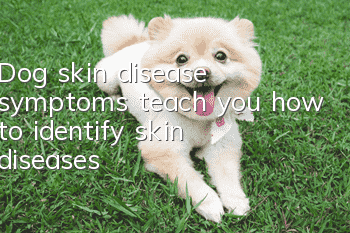Dog skin disease symptoms teach you how to identify skin diseases

Symptom 1 of dog skin disease: fungal infection
1. The affected area is generally oval or round, with a clear boundary with healthy skin.2. The scabs are easy to peel off. The skin will be smooth after peeling off. The skin will not thicken, but will form large areas of ringworm spots, such as honeycombs, and the itching will not be strong.
3. There are tiny skin flakes, like scales.
Dog skin disease symptoms two: mites
1. The affected area has no regular shape, mostly small bumps, and the boundary with healthy skin is not very obvious, and the area is generally large and wide.2. The skin of the affected area is thickened, chapped, bleeding, and secretions ooze out.
3. The affected area is itchy.
4. Will not cause odor.
5. There are relatively large flakes or scabs.
Symptom 3 of dog skin diseases: lice and fleas
If you peel back the dog's coat, you can see the small black spots (feces) and small white spots (eggs) left by fleas on the body.Dog skin disease symptoms four: pyoderma
1. Pustular rashes, small pustules and purulent secretions appear on the dog’s skin.2. There are symptoms of severe hair loss, the affected area emits a fishy smell, and there is pus oozing out.
Dog skin disease symptoms five: seborrheic dermatitis
1. There are gray-white or silver dry scales scattered in the coat.2. The skin and coat at the base of the tail with developed sebaceous glands have yellowish-brown oil patches attached to them.
3. The affected area has symptoms of itching, accompanied by scales and severe hair loss.
4. Affected areas are more common on the back, auricles, back of the tail, lower chest, elbows, joints, etc. Due to itching and biting, the affected areas are easy to expand and the lesions are aggravated.
Dog skin disease symptoms 6: Eczema
Acute eczema: In the early stage of the disease, the affected area appears as punctate or erythematous eczema with different shapes. Dogs experience itching, and as the condition progresses, papules, blisters, and pustules may appear.Chronic eczema: It is often caused by the transformation of acute eczema, with repeated stimulation and repeated attacks. It is characterized by thickened skin, desquamation, pigmentation, rough coat, and increased itching. It is usually more common on the back or limbs.
Random articles
- How to clean the anal glands of dogs? How to express the anal glands correctly?
- When is the best time to neuter Akita dogs? What are the advantages and disadvantages of neutering Akita dogs?
- What to do if your dog has heat stroke? Here are some tips you must know
- Are dogs afraid of getting wet when it rains? Will dogs die if they get caught in the rain?
- Why you can’t pull your dog’s tail because it may cause lifelong disability
- What does it mean when a dog tilts its head? It may not be what you know about tilting its head.
- Can dogs eat lychees? Will dogs die if they eat lychees?
- How to deal with postpartum lochia in Anatolian Shepherd Dogs Tips for dealing with postpartum lochia in dogs!
- Will dogs vomit if they have heat stroke? What are the symptoms of heat stroke in dogs?
- How often does a dog menstruate? Do you know why dogs menstruate?



